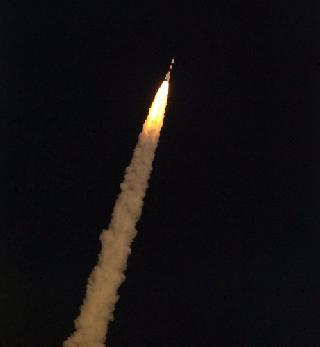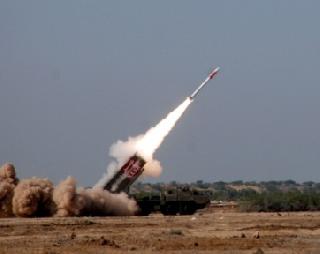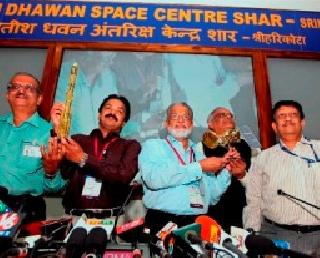
The PSLV C25 carrying "Mangalyaan" soars into the high skies. A PTI photo
SRIHARIKOTA (PTI): India's maiden mission to Mars was successfully launched on Tuesday with its polar rocket placing the Mars spacecraft precisely into an intended Earth orbit in its first-ever historic inter-planetary odyssey in a bid to join a select band of nations.
In a "new and complex mission design", ISRO's PSLV-C25 successfully injected the 1,350-kg 'Mangalyaan' Orbiter ('Mars craft' in Hindi) into the orbit around Earth some 44 minutes after a text book launch at 2.38 PM from the Satish Dhawan Space Centre in Sriharikota, marking the successful completion of the first stage of the Rs 450 crore mission.
"The PSLV C25 vehicle has placed the Mars Orbiter spacecraft very precisely into an elliptical orbit around Earth," ISRO chief K Radhakrishnan said after the launch.
This is the 25th flight of the Polar Satellite Launch Vehicle (PSLV) and "it has been a new and complex mission design to ensure that we would be able to move the MARS Orbiter spacecraft from the orbit of Earth to the orbit of MARS with minimum energy," he said from Mission Control Room.
After going around Earth for 25 days in an elliptical orbit (perigee of 250 km and apogee of 23,500 km), the golden coloured probe, the size of a small car, would embark on a 10-month long voyage to Mars around 12.42 AM on December 1.
It is expected to reach the Red Planet's orbit by September 24 next and go around in an elliptical orbit (periapsis of 366 km and apo-apsis of 80,000 km).
"I am happy to say the spacecraft is in good health. It has done a task what had to be done," a visibly relieved and happy Radhakrishnan told reporters.
The rocket injected the satellite into Earth's orbit over South America, which was captured by ISRO's sea-borne terminals on board Shipping Corporation of India's vessels SCI Nalanda and SCI Yamuna in the South Pacific Ocean.
There was a data break of over 10 minutes as expected after burn-out of the third stage and the Mission Control Centre got signals on ignition of the fourth stage.
"The biggest challenge will be precisely navigating the spacecraft to Mars," said Radhakrishnan, adding, "We will know if we pass our examination on Sept. 24, 2014."
The robotic satellite, which is undertaking the over 200-million-km long journey to Mars, is equipped with five instruments, including a sensor to track methane or marsh gas - a possible sign of life - on Mars.
If all goes well and the satellite orbits the Red Planet, ISRO will become the fourth in the world after those of the US, Russia and Europe to undertake a successful Mars mission. The Mars missions of China and Japan have failed.
 Previous Article
Previous Article Next Article
Next Article












The Indian Air Force, in its flight trials evaluation report submitted before the Defence Ministry l..
view articleAn insight into the Medium Multi-Role Combat Aircraft competition...
view articleSky enthusiasts can now spot the International Space Station (ISS) commanded by Indian-American astr..
view article